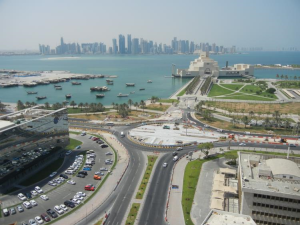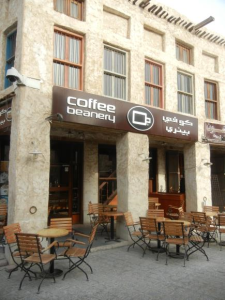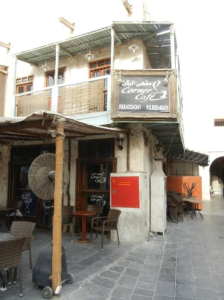On my way to Houston, Texas, I decided to stop in Doha, Qatar, for a couple of days. We live in interesting times. I arrived in the city in the midst of a major terrorist alert, with the U.S. having closed many of its embassies and consulates throughout the region, including in Doha. But if I had not been following the news for the past few days (unlikely since I’m pretty much addicted to reading news reports) I would not have noticed anything out of the ordinary. The view from my hotel window looked enticing and I was soon strolling around the streets near to the hotel without any problems. The Museum of Islamic Art (MIA) was located just a short walk from the hotel. I had planned to visit the museum to see the Steel and Gold exhibition of historic swords from the museum’s collection. The museum’s website states that during the month of Ramadan the museum is open as normal after the third day of the month. What it doesn’t state is that this does not include the last 10 days of Ramadan, during which the museum is closed! So while I had a fantastic view of the museum, next to the Gulf waters, and with downtown Doha as a stunning backdrop, I couldn’t actually visit the place. But I’m sure I’ll be visiting the city again in the not too distant future, with my family, so I was not too upset about that.

View of the Museum of Islamic Art from my hotel room. Dhow Harbor is to the left of the museum and downtown Doha in the distance.
I arrived on what turned out to be the last day of Ramadan, and so on my first evening I made a reservation for the iftar dinner in the hotel restaurant and decided that after eating I’d take a stroll to famous Souq Waqif, the traditional Qatari market that dates back hundreds of years. The iftar buffet was excellent. There were many choices of different meat and fish dishes, and some tasty vegetable dishes. I especially enjoyed the lamb soup. The souq was about a 15-minute walk from my hotel; which was the Horizon Manor Hotel on Jaber Bin Mohamed Street near to the Islamic art museum and dhow harbor. Apart from looking around the market I wanted to visit Asherg Cafe, a traditional Arab cafe that includes a rooftop patio and a view of the Gulf and market streets. It is a good place from which to sip some mint tea while feeling the warm ocean breeze and dreaming of hitching a ride with Sinbad on another one of his adventures! Unfortunately, I had to settle for wafts of scented shisha smoke and the thumping beat of Arab pop music. But there was certainly a warm breeze; the view was lively; and I enjoyed some sweet tea with a sprig of fresh mint served to me by a waiter from Nepal.
I must have spent a couple of hours wandering around the souq. The market shops are partly outside and partly under cover in air-conditioned spaces. The entire souq is made up of narrow streets lined by tightly packed stores, many of which offer the same types of wares. These include traditional Arab clothing; perfume; food products such as spices, dried fruits, nuts, coffee and tea, and honey; prayer rugs; household items such as pots, pans and coffee pots; scarves; and all kinds of trinkets, most of which seem to be made in either Pakistan or China. The best thing about Souq Waqif for me was the sheer number of cafes. The whole souq is like a Mecca for coffee shops. If someone wanted to go on a cafe crawl, this would be the place to do it. Asherg Cafe was probably the largest that I saw but there were many other smaller cafes that had their own unique atmosphere and appearance. I had a cappuccino at the Coffee Beanery – a U.S.-based company – on Al Souq Street, just a short walk from Asherg Cafe.
The cafe had a huge selection of different coffees – the usual cappuccino, latte and espresso coffees as well as more exotic formats such as different types of mocha, iced, and frappalette coffees, as well as sandwiches and pastries. I sat upstairs in the nonsmoking area. There was a large wall-mounted television opposite my table that was tuned to the BBC World News (you can’t escape it!). The presenter was talking live from a park in London that I had visited in June. Small world. The Coffee Beanery was not very busy when I arrived at around 9 p.m. but it filled up after a while. There was seating outside under a covered walkway, as well as inside on the ground floor and upstairs, which included a long row of small round tables next to a series of wood-framed windows that looked out onto the street outside. This seating area looked like a good place to sit but it was the smoking section. Ironically, most people were crammed into the smaller nonsmoking area and the much larger smoking area was almost empty! The floor of the café was covered in small terracotta-looking tiles in unusual irregular shapes that really caught my attention from their design and the ceiling was lined with what looked like thin strands of wood cane between wide beams of teak wood. I really enjoyed the place and stayed there for at least an hour. I had actually been trying to find Asherg Cafe but could not find it and after searching through a series of narrow market streets I came across the Coffee Beanery, which looked pretty good. I found out from the waitress there that the rooftop cafe I had been searching for was just a short walk further along the street. I had to see this cafe because it had a good writeup in my Lonely Planet guide (in which it is spelt “Eshairiq Coffeehouse” for some reason; possibly from a different translation of the Arabic) and so after finishing my coffee I walked straight from the Coffee Beanery to Asherg Cafe, nearly getting run down by a hurrying street vendor in the process. There were many people seated in the street but I walked up the steps to the rooftop patio, where I found a table overlooking the market below and ordered a mint tea. The cafe dominated a large open space – much like a square in European cities – on the side of the souq closest to the ocean. Ramadan had just ended and everyone seemed to be in a relaxed mood, probably happy to have finished the month of fasting.
After finishing my mint tea I left the cafe and continued along Al Souq Street and noticed several other cafes, including Corner Cafe right next to The Coffee Beanery. This looked like the most traditional cafe I’d seen but as I walked along the street I found several others. After about 30 minutes of wandering I eventually came across a mosque near the edge of the souq called Masjid Al Maaneh, a mosque with a large and artistically tiled open space at the front and a short minaret, which some other writers have likened to a lighthouse. I stopped in a nearby hotel to ask about the mosque and was told that it is named after a local family that owns much of the land on which the souq was built.
The souq was full of people out enjoying the beginning of the ‘Id al-Fitr holiday. Being conscious of cultural sensitivities around photography, I resolved to return to the souq early the following day to take some more pictures of some of the places I’d seen. So most of the photos accompanying this article were taken around 7 a.m. when there were few people around. Although the market shops were closed at this time, it was a good time to be wandering around for photo opportunities because by about 8:30 a.m. the day was already too hot and humid to be able to walk and feel comfortable. By the time I got back to my hotel I was covered in perspiration and moisture from the humidity and had to take another shower to cool down.
In addition to the standard souq fare, there are some shops in the market that sell more unique and high quality items, such as ceramic sculptures and original paintings. I came across one place that makes traditional Arabian swords. Three of them were on display in the window. The machinery and other tools used to make them were also on display in the store. Close to this store, there was a place that makes model dhow boats, the traditional boats used for fishing and transportation in the Gulf region. Souq Waqif also includes several boutique hotels, which looked as though they are fairly expensive.
The present souq is the result of recent renovations that began in 2004. The architecture captures traditional Qatari architectural styles from hundreds of years ago. The souq does look a little like a movie set, and, indeed, it has been used as a backdrop for several films; but walking around the narrow passageways was an enjoyable way to spend some time. During the day, the souq looks somewhat artificial in places, but at nighttime, when it is bustling, it comes alive and you can feel that you are in old Arabia.
Doha is a city of contrasts. There is the old traditional side of the city, perhaps typified by Souq Waqif and the surrounding area and the dhow harbor, and there is the ultra-modern side of the city, centered on the downtown area where every tall building looks new and you feel that they must have all won awards for innovative design. My hotel was a place of contrasts too. As soon as Ramadan had ended, the posters in the elevator advertising the iftar buffet were taken down and replaced by posters advertising the night club up on the 14th floor. It was back to business as usual.
On the second day of my visit I took a taxi from the hotel to the City Center shopping center to visit the cinema. I watched The Lone Ranger, which despite some poor reviews, was actually a very clever and entertaining film. I certainly enjoyed it. The only aspect of the film that I was slightly disappointed with was the fact that the filmmakers had used Monument Valley in Utah for the film’s backdrop, whereas the story was supposed to have been set in Texas. The filmmakers had obviously tried to be innovative in the way they presented the story of Tonto and the Lone Ranger, with more emphasis on the role of Tonto, but in terms of setting the film followed the long tradition of Hollywood myth making about the “Old West.” The City Center was certainly worth a visit, with its variety of shops, restaurants and cafes; and the taxi ride there from my hotel, along the corniche and then through downtown, allowed me to view some of the buildings for which Doha has become famous. On my next trip here, I think I’ll stay in the downtown area so that I can spend more time visiting the modern city. For fellow travelers, a note of caution about taxis. The taxi driver who met me at my hotel charged me 40 riyals to take me to City Center whereas on the return journey to the hotel the driver charged me only 12 riyals. So it would have been better if I’d called a taxi myself while at the hotel.
Well, I’ve had an excellent two day stay in Doha. Despite the disappointment of not being able to visit the Museum of Islamic Art, I’ve seen enough to make me want to come back for many more visits. Next time, I’ll bring my family with me and we’ll explore more of the city together.





No comments yet.